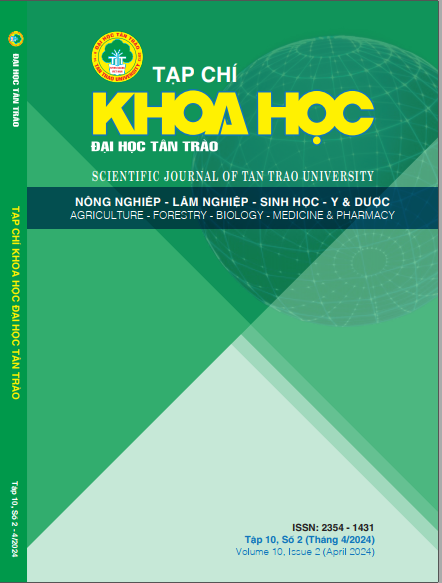TỶ LỆ HUYẾT THANH DƯƠNG TÍNH VỚI ẤU TRÙNG TOXOCARA CANIS VÀ MỘT SỐ YẾU TỐ LIÊN QUAN Ở NGƯỜI DÂN XÃ CUÔR KNIA, HUYỆN BUÔN ĐÔN TỈNH ĐẮK LẮK
DOI:
https://doi.org/10.51453/2354-1431/2024/1136Từ khóa:
Giun đũa chó, huyết thanh dương tính, tỉnh Đắk LắkTóm tắt
Mục tiêu: Xác định tỷ lệ huyết thanh dương tính với ấu trùng Toxocara canis tại xã Cuôr Knia, huyện Buôn Đôn, tỉnh Đắk Lắk năm 2020.
Đối tượng và phương pháp nghiên cứu: Tất cả người dân từ 3 tuổi trở lên có hộ khẩu và sinh sống tại xã Cuôr Knia, huyện Buôn Đôn, Tỉnh Đắk Lắk.
Phương pháp nghiên cứu: Thiết kế nghiên cứu cắt ngang.
Kết quả và bàn luận:
- Tỷ lệ huyết thanh dương tính ấu trùng Toxocara canis chiếm 39,01%, trong đó tỷ lệ huyết thanh dương tính ở nam và nữ là tương đương (40,00% so với 38,29%), (p > 0,05); nhóm ≥ 15 tuổi chiếm 42,80%; nhóm < 15 chiếm 25,30% (p < 0,01).
- Có mối liên quan có ý nghĩa thống kê giữa tỷ lệ huyết thanh dương tính với ấu trùng Toxocara canis ở nghề nông và học sinh (48,8% so với 15,8%), giữa học sinh và nghề khác (15,8% so với 30,9%), (p < 0,01). Không có mối liên quan có ý nghĩa thống kê giữa tỷ lệ huyết thanh dương tính với ấu trùng Toxcara canis ở nghề nông và nghề khác (48,8% so với 30,9%), (p > 0,05).
- Không có mối liên quan có ý nghĩa thống kê giữa dân tộc, trình độ học vấn và tỷ lệ huyết thanh dương tính với ấu trùng Toxocara canis (p > 0,05).
- 32,62% đối tượng nghiên cứu có chỉ số bạch cầu ái toan ở mức bình thường (< 5%) và 79,19% tăng (≥ 5%), (p < 0,05).
Tải xuống
Tài liệu tham khảo
Ministry of Health (2022). Guidelines for diagnosis, treatment and prevention of canine/ feline roundworm larvae (Issued with Decision
No. 1385/QD-BYT, dated May 30, 2022 of the Minister of Health).
Araújo, A. C., Villela, M. M., Lopes, Â. S., etal (2018). Seroprevalence of Toxoplasma gondii and Toxocara canis in a human rural population of Southern Rio Grande do Sul.Revista do Instituto de Medicina Tropical de São Paulo, 60:e28:1-7.
Bui Van Tuan (2018). Current status, some factors related to Toxocara canis infection in humans in Mo Duc district, Quang Ngai province in 2016 and the effectiveness of some intervention measures. Doctoral thesis in medicine. Central Institute of Hygiene and Epidemiology.
Pezeshkian, F., Pouryousef, A. M., Omidian, M.,et al (2023). Seroprevalence of Toxocariasis and Its Associated Risk Factors among Adult Population in Kavar District, Fars Province, South of Iran: A Cross - Sectional Community - Based Seroepidemiological Survey.
Interdisciplinary Perspectives on infectious diseases, Article ID 2721202, 7 pages. https://doi.org/10.1155/2023/2721202.
Phan Thong (2018). Rate of positive serum for Toxocara spp. and some related factors of people in Quang Hiep commune, Cu M’gar district, Dak Lak province, 2018. Master’s thesis in Medical Parasitology. Tay Nguyen University.
Phasuk, N. & Punsawad, C (2020). Seroprevalence of Toxocara canis infection and associated risk factors among primary schoolchildren in rural Southern Thailand. Tropical medicine and health, 48(1), 1-8.
Said, A., Khattak, I., Abbas, R. Z., et al (2023).
Toxocara canis seropositivity in different exposure groups in the Khyber Pakhtunkhwa province of Northwest Pakistan. Pararasitology Researsh, 122, 1159-1166. https://doi.org/10.1007/s00436-023-07816-4.
Thai Phuong Phien, Truong Van Hoi, Le Vu Chuong et al (2021). Current status and some factors related to seropositivity for Toxocara spp. in people in Ninh Thuan province, 2020. Journal of Malaria and Parasitic Diseases
Prevention, Central Institute of Malaria - Parasitology - Entomology, 1(121), 41-49.
Tran Van Lap (2018). Seropositivity rate for Toxocara canis in humans and some related factors of people in Ea Phe commune, Krong Pak district, Dak Lak province, 2018. Master’s thesis in Medical Parasitology. Tay Nguyen University.
Tải xuống
Đã Xuất bản
Cách trích dẫn
Số
Chuyên mục
Giấy phép

Tác phẩm này được cấp phép theo Giấy phép Quốc tế Creative Commons Attribution-ShareAlike 4.0 .
Bài báo được xuất bản ở Tạp chí Khoa học Đại học Tân Trào được cấp phép theo giấy phép Ghi công - Chia sẻ tương tự 4.0 Quốc tế (CC BY-SA). Theo đó, các tác giả khác có thể sao chép, chuyển đổi hay phân phối lại các bài báo này với mục đích hợp pháp trên mọi phương tiện, với điều kiện họ trích dẫn tác giả, Tạp chí Khoa học Đại học Tân Trào và đường link đến bản quyền; nêu rõ các thay đổi đã thực hiện và các nghiên cứu đăng lại được tiến hành theo cùng một bản quyền.
Bản quyền bài báo thuộc về các tác giả, không hạn chế số lượng. Tạp chí Khoa học Tân Trào được cấp giấy phép không độc quyền để xuất bản bài báo với tư cách nhà xuất bản nguồn, kèm theo quyền thương mại để in các bài báo cung cấp cho các thư viện và cá nhân.
Mặc dù các điều khoản của giấy phép CC BY-SA không dành cho các tác giả (với tư cách là người giữ bản quyền của bài báo, họ không bị hạn chế về quyền hạn), khi gửi bài tới Tạp chí Khoa học Đại học Tân Trào, tác giả cần đáp ứng quyền của độc giả, và cần cấp quyền cho bên thứ 3 sử dụng bài báo của họ trong phạm vi của giấy phép.






